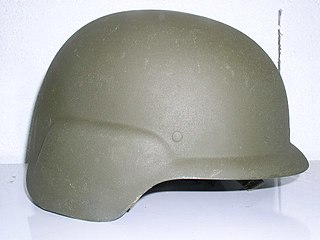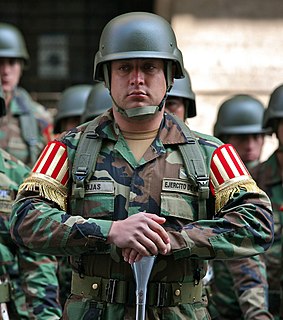
Kevlar (para-aramid) is a heat-resistant and strong synthetic fiber, related to other aramids such as Nomex and Technora. Developed by Stephanie Kwolek at DuPont in 1965, the high-strength material was first used commercially in the early 1970s as a replacement for steel in racing tires. It is typically spun into ropes or fabric sheets that can be used as such, or as an ingredient in composite material components.
Twaron is a para-aramid. It is a heat-resistant and strong synthetic fibre developed in the early 1970s by the Dutch company Akzo Nobel's division Enka BV, later Akzo Industrial Fibers. The research name of the para-aramid fibre was originally Fiber X, but it was soon called Arenka. Although the Dutch para-aramid fiber was developed only a little later than DuPont's Kevlar, the introduction of Twaron as a commercial product came much later than Kevlar due to financial problems at the AKZO company in the 1970s.

Personnel Armor System for Ground Troops is a combat helmet and ballistic vest that was used by the United States military from the early 1980s until the mid-2000s, when the helmet and vest were succeeded by the Lightweight Helmet (LWH), Modular Integrated Communications Helmet (MICH), and Interceptor Body Armor (IBA) respectively.

The Modular Integrated Communications Helmet (MICH) is a U.S. combat helmet and one of several used by the U.S. military. It was developed by the United States Army Soldier Systems Center to be the next generation of protective combat helmets for use by the U.S. Army.

The SPECTRA helmet or CGF Gallet Combat Helmet is the PASGT-style ballistic helmet in use with the French military, and the armies of several other countries. Built by CGF Gallet, it weighs 1.4 kg (3.1 lb), is available in three sizes, and is made from ultra-high-molecular-weight polyethylene Spectra fibers, produced under license from Honeywell.

The Advanced Combat Helmet (ACH) is the United States Army's current combat helmet, used since the early 2000s. It was developed by the United States Army Soldier Systems Center, the U.S. Army Special Operations Command, and the U.S. Army Research Laboratory to be the next generation of protective combat helmets for use by the American ground forces. The ACH is derived from the Modular Integrated Communications Helmet. The ACH is currently in the process of being phased out and replaced by the Enhanced Combat Helmet (ECH), an improvement upon the ACH derived from its design; however, both the ACH and the newer ECH are being replaced by the Integrated Head Protection System.

The Mk 6 helmet is a type of combat helmet that was the standard of the British Armed Forces as well as another supplied helmet of the UN during peacekeeping operations. The Mk 6 replaced the Mk IV helmet in army service and the RAC helmet in naval service. The jump in MK numbers is thought due to the confusion surrounding the MK IV helmet using the MK V lining, introduced in 1959. The MK 6, introduced into service from the 1980s, is designed to accept modern ear protection, Bowman personal radios, and respirators. The helmet is manufactured by NP Aerospace, and is reported to have an "almost unlimited service life" by the manufacturer.

A combat helmet or battle helmet is a type of helmet, a piece of personal armor designed specifically to protect the head during combat.

The CG634 is the Canadian Armed Forces' main combat helmet. It was introduced in 1997 and is based on the French Gallet TC-3 helmet. The helmet has protection equal to an NIJ Level 3a rating, being able to stop a shot from a .357 Magnum.
The Enhanced Combat Helmet (ECH) was the standard issue combat helmet of the Australian Defence Force, introduced in 2004 to replace the M91 helmet, an Australian version of the American PASGT helmet, it was replaced by the Team Wendy EXFIL Ballistic helmet from 2015 It is manufactured by Israeli company Rabintex, and was selected in a competition between four rival designs. It is the same shape as the U.S MICH 2000 helmet, but is lighter in weight and has a Bundeswehr M92 helmet-style padded headband/crown pad suspension system. It retains the 3-point chin strap that was used on the previous Australian M91 helmet. The Enhanced Combat Helmet has four sizes. It was also in service with the New Zealand Defence Force from 2009 to 2019. Its Rabintex model number is RBH 303 AU.

The SSh-68 - is a steel combat helmet of the Soviet and then Russian Armed Forces. The SSh-68 is a further development of the SSh-60 helmet. It differs primarily in its greater strength, greater front slope of the dome and the shorter outer edge. It is usually painted in dark green.
The OR-201, also designated Kasda OR-201 Model 76 or M-76 for short, is a combat helmet of Israeli origin. Developed in the 1970s, the OR-201 was one of the world's first ballistic helmets. It was subsequently exported on a large scale and has been used by many militaries worldwide.

The GOLFO is a combat helmet of Chilean origin issued to the Chilean Army. The helmet is produced locally by the Chilean private firm Baselli Hermanos Brothers S.A. and was first introduced in 2000; Made of kevlar, it is capable of stopping a 9×19mm round at 310m.
The M63 is a combat helmet of South African origin. Based on the French Modèle 1951 helmet, the M63 replaced the British type Brodie helmets during the early 1960s, and saw extensive use during the Rhodesian and Angolan bush wars. It was issued until the 1980s when it was replaced by the M87 kevlar helmet.
The M87 is a combat helmet of South African origin manufactured by South African Pith Helmet Industries (S.A.P.H.I) of Rosslyn. The kevlar composite M87 replaced the steel M63 helmet during the late 1980s, and saw extensive use during the South African Border War, which took place from 1966 to 1989 in South-West Africa (Namibia) and Angola. It is the current standard helmet of the South African National Defence Force.
AuTx is a terpolyaramide fibre that was developed during 2005 to 2012 by Alchemie Group. It is based on Russian aramid fibres. AuTx-FR is a fire resistant fibre with high thermal stability and high LOI and strength at elevated temperatures, with minimal thermal degradation. The process of forming AuTx-FR fibres allows the LOI to be varied between 40-70 with a trade-off for lesser strength the higher the LOI number is.
The BK-3 is a Croatian Combat helmet produced by Šestan-Busch, and is the standard combat helmet of the Croatian Armed Forces. It is also widely exported to many NATO and Middle Eastern customers.

The QGF03 helmet is a combat helmet deployed by the Chinese People's Liberation Army in 2005. The helmet, like its predecessor the QGF02, is made from a kevlar composite material and replaces older steel helmets such as the GK80 for frontline troops.

The Gefechtshelm M92 is the standard issue combat helmet of the Bundeswehr, first fielded in 1992 as a replacement of earlier M1956 steel helmets that were previously used during the Cold War. It is made from Aramid composite materials and is used by all branches of the Bundeswehr.












